When I first discovered the Stories of Barrington J. Bayley secreted in hoarded
copies of early-70's New Worlds he was something of a cult figure. A name
to trade in rituals of credibility and literary one-upmanship. His titles like
"Exit From City 5", "The Cabinet of Oliver Naylor" and "The Four Colour Problem"
were the key admission words to an inner cognioscenti who knew that the vortex
of his ideas could open up the readers skull, leaving the cerebral cortex
staggeringly punchdrunk, shimmering like a mind-blown jellyfish. He kicked the
concept-quotient into metaphysical overdrive and seemed to have the ability -
like the robotician in his SOUL OF THE ROBOT novel - to
remove an inspection
plate from the back of your head to make adjustments to the exposed intellect.
He treats science fiction as a conceptual game, and in the process has created
some of the most perfectly crafted examples of the SF genre ever produced. Like
the whole plethora of New Worlds spawned writers Bayley was classified as
'New Wave', yet to a degree unique to that, at best ungainly, bracketing, he
operates within the traditional science fiction horizons, grabbing and
refurbishing the hardware, giving it undreamed of ontological wings and
additional conceptual dimensions. Fleshing out the genre's skeleton into a vital
form of dizzying consciousness-expanding creative literature.
He was born in Birmingham on 8 April 1937, spending his childhood in the blitz
when, according to an American blurb, 'the Luftwaffe made nightly attempts to
prevent him from reaching school age'. Since then he's lived in Shropshire,
London, Scotland, and Ireland, before settling in Shropshire with his wife and
two children. He endured 'disastrous' jobs as a reporter, a civil servant,
working in private industry and even tried his hand at coal mining. All the
while he was writing. One of his earliest extant stories, "Aid to Nothing", was
written when he was 16, but didn't surface in print until 1967. In the meantime
another tale slunk into a 1956 Vargo Statten Magazine, marking the first
appearance of his robotic protagonist Jasperodus, berifit of his later
metaphysical protuberances. He also sold material to Authentic and
Nebula. "The Seed of Evil" germinated around this period, a novelette
with the scope of an Olaf Stapledon epic in miniature. It charts the pursuit
across time of an immortal alien by Julian Ferrg who hopes to wrest from him the
secret of his longevity. The hunt takes them beyond the extinction of the human
race and into the dawning of its replacement species, Lupos Sapiens, the
intelligent wolf. The story was first drafted when Bayley was 16 or 17, and was
rewritten numerous times before it eventually reached print - in 1973! For
Bayley it was a period 'bursting with ideas and images, but lacking the
ability to make proper use of them'. There were 'mood pieces, short
on plot, which tended to hang on some philosophical idea,' and 'awkward
stories, clumsily constructed around intellectually top-heavy notions'.
A connection with Michael Moorcock, then emerging from his editorial wunderkind
period with Tarzan Adventures, proved to be mutually beneficial. They
collaborated on a short story called "Going Home", published as the work of
Moorcock. It was a 'slight story' according to Mike Ashley (in SF
Monthly) telling of 'a dead Earth of the far future to which two immortal
humans return hoping to find an answer to an unasked question'. The story
garnered Moorcock his first sale to an adult publication, Moorcock returned the
favour by introducing Bayley to the field of juvenile writing. Further
collaborations followed, there was a 'rambling, inchoate, highly colourful
Space Opera' novel that never reached publication [until 1995, when Time
Centre Times published "Duel Among the Wine Green Suns" under the pseudonym
Simon Barclay -JL.], plus mounds of childrens features, stories, and picture-
strips that did. Embryo science fiction readers of the early-60's might have
read Bayley's "The Astounding Jason Hyde" in Valiant, while he recalls
competing with the legendary Frank Pepper (creator/scripter of Captain Condor,
Jet-Ace Logan and Dan Dare) for the "Zip Nolan" commission for Lion. As
well as providing a source of income the work instilled the disciplines
necessary for professional writing; the ability to work to deadlines, to wordage
limitations, and to plot commercially acceptable products; to give form and
structure to the earlier 'mood pieces' and 'top-heavy notions'. He also wrote
straight science features, including what was probably the first accurate
account of lasers comphrehensible to a 12-year old.
The balance between idea and vehicle was still wrong, resulting in a fervour of
creativity, a flow of images piling up, but finding no satisfactory outlet. A
quest for form that did, however, produce a gem in "Ship of Disaster".
Sympathetically illustrated by Jim Cawthorn it was totally unlike anything else
Bayley had attempted before, or since. A Tolkienesque fantasy of Elves 'rejected
by Earth'. But, such one-off successes excepted, the personal and artistic
imbalance inducted compromised sales, breeding cynicism about publishing
standards and the integrity of writing in general. Although his dismissal of
such early work as "Consolidation" has some justification it is also true that
many of his ideas were too advanced for the simplistic Space Opera that the
market was greedy for at the time. His occasionally didactic approach and
attitude to science fiction - which was to become common currency during the New
Wave explosion of the late-60's - must have been received with blank
incomprehension by the staunchly Campbellian puppet-masters of the U.K.
publishing scene. This double interface of incompatability becomes only apparent
in retrospect, to Bayley it was a problem that persisted throughout his third
decade until he all but abandoned writing, feeling that 'the whole of
literature was a useless and self-deluding endeavour, and that all writers were
victims of a kind of mental illness'.
The impasse seemed intractable. Bayley disengaged himself from his scripting
commitments and for a year or two did nothing but study until the money ran out.
The palliative was William Burroughs, the spiritual guru and spectral architect
of the New Wave. 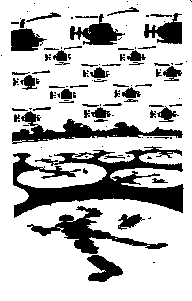 While living
in Dublin Bayley read THE NAKED LUNCH, one of the most uncompromisingly experimental
novels of the century. The effect was a slap in the mind, by example as well as by
technique. The first piece he regurgitated under its pervasive influence was "The
Four Colour Problem", a densely worded mindbuster, part thesis, part cut-up comment,
interacting and cohabiting the page in perfect artistic cohesion. The Burroughs
influence is overwhelming, with repetitive motifs of 'pulse trains', 'social ovens',
'a blazing bomber plunging down bottomless pits', Vietnam, the Ohio State and Kennedy
killings, DNA, and the Four Colour problem itself linked by sharp jagged vignettes of
fragmented military and vorticed political satire in a continually unfolding juxtaposition
of imagery. There is explication on forms of addiction, geometric diagrams, and even a
Doctor Benway figure in Bayley's Professor Gottram, compounded by Burroughs ubiquitous
sex-energy references. Written in a manic high pitch of tension, and illustrated by for
New Worlds by the late Mal Dean, it remains his
most personally satisfying text ever.
While living
in Dublin Bayley read THE NAKED LUNCH, one of the most uncompromisingly experimental
novels of the century. The effect was a slap in the mind, by example as well as by
technique. The first piece he regurgitated under its pervasive influence was "The
Four Colour Problem", a densely worded mindbuster, part thesis, part cut-up comment,
interacting and cohabiting the page in perfect artistic cohesion. The Burroughs
influence is overwhelming, with repetitive motifs of 'pulse trains', 'social ovens',
'a blazing bomber plunging down bottomless pits', Vietnam, the Ohio State and Kennedy
killings, DNA, and the Four Colour problem itself linked by sharp jagged vignettes of
fragmented military and vorticed political satire in a continually unfolding juxtaposition
of imagery. There is explication on forms of addiction, geometric diagrams, and even a
Doctor Benway figure in Bayley's Professor Gottram, compounded by Burroughs ubiquitous
sex-energy references. Written in a manic high pitch of tension, and illustrated by for
New Worlds by the late Mal Dean, it remains his
most personally satisfying text ever.
Significantly - although undoubtedly previous editorial regimes would have
shoved the rejection slips with proverbial barge poles - the axis was shifting.
Moorcock was now at the New Worlds helm, setting the controls for the
heart of the sun. "The Four Colour Problem" became one of the incendiary devices
in his broadside assault on sterility and lack of vision. The period also
produced another 'watershed' story, "All the Kings Men", which he was convinced
was unsaleable. He sat on it for a couple of years, then showed it to Moorcock
who announced it the best story he'd ever read. He backed up the verdict by
publishing it no less than three times. The theme dominating the story is that
of alieness, not the Marxist but the Cartesian division between consciousness
and the virtual world of the senses. A division personified by an extra-
terrestrial King of Britain who finds the human mentality unintelligible,
despite his basically benevolent motivations. A later story "The Infinite
Searchlight" continued the polarisation of phenomena positing a deliberate
imposition of sentience onto inanimate matter with the brain acting as a radio
receiver picking up transmitted consciousness. The tale ends with the
transmitter being accidentally switched off.
The stories now flowed in perfect conceptual balance and found a ready, even
voracious market. A story called "The Exploration of Space" used sentient chess
pieces as metaphors to explore the nature of 'space' (another preoccupation from
"All the Kings Men"), which was to recur obsessively. The term 'space' used not
in its E. E. "Doc" Smith sense, but as a physicist might abstract the term. An
idea of the interrelationship of mass under pressure to the space it occupies
producing a story ("The Radius Riders") proving that the Earth is at least
eleven light years across! A disasterous discovery for the Terranauts who become
its victim. The story's incidental idea of 'Subearthers' whose greater density
allows them free movement through solid rock is related directly - by a Russian
Doll principle - to "The Ship that Sailed the Ocean of Space".  The title quite literally describing a ship existing in some other, more tenuous,
dimension, only its keel extending down into the abyss of what we understand as
the universe. To its crew we are the Subearthers. Into the realm of even greater
tenuity "Exit from City 5" proffered the idea of a self-perpetuating society
escaping the extinction of the entire sidereal universe by going beyond into
the total void of theoretical nothingness. By a simple inversion of this spatial
condition Bayley produced a universe of solid rock flecked with inhabited
air-pocket 'planets' in "Me and my Antronoscope". The problem afflicting this
society being that of procuring 'fresh emptiness'.
The title quite literally describing a ship existing in some other, more tenuous,
dimension, only its keel extending down into the abyss of what we understand as
the universe. To its crew we are the Subearthers. Into the realm of even greater
tenuity "Exit from City 5" proffered the idea of a self-perpetuating society
escaping the extinction of the entire sidereal universe by going beyond into
the total void of theoretical nothingness. By a simple inversion of this spatial
condition Bayley produced a universe of solid rock flecked with inhabited
air-pocket 'planets' in "Me and my Antronoscope". The problem afflicting this
society being that of procuring 'fresh emptiness'.
Some of the best stories from this period have been collected into two
anthologies, KNIGHTS OF THE LIMITS and a selection by
John Clute called THE SEED OF EVIL. For me his most
accomplished piece is "The Cabinet of Oliver Naylor",
illustrated for New Worlds by the excellent Dave Britton. Its polyglot
cross-cultural references and its wide-ranging economic and social eclectisism
are rapacious, equalled only by its breath-taking inventive vision recalled
through a set of his best realised characters and inter-character relationships.
There is the sensualist artist Corngold and his submissive mistress living in a
'habitat' on the shores of a 'matterless lake' where 'even such elementary
characteristics as direction, distance and dimension' are missing, because they
are 'lent to space... by the signposts of matter'. And there is Naylor himself
with his Thespitron of random dramatic output with unlimited repertoire, his
problem with absolute identity, and his habitat propelled at C186 by
the Harkham Velocitator, galaxies viewed like a blurring of sleet from his window.
The whole enterprise is propelled - at a similar velocity - by Bayley's most
compulsively fluid plotting. The juxtaposition in which Britain has assumed
leadership of expansion into the universe through a reversion to the Victorian
back-yard inventor (like Wells' Cavor), and the American conceptual contribution
of media-derived Hollywood pastiche is conveyed with an intuitive feel for the
tactile possibilities of key-words or adjective clusters; while there are sufficient
spin-off ideas to fuel several competent novels.
After so many short stories the next stage, logically, was novels. A New
Worlds novelette called "Star Virus" attracted favourable comment. 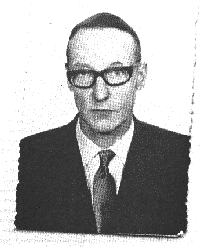 Bayley
met William Burroughs at a party, and the venerable beat complemented certain
passages. John Brunner was also highly vocal in urging Bayley to expand the
piece to novel-length. A contract with Don Wollheim of DAW books reduced
options into commitments, and Bayley settled down and became a novelist. The re-
alignment inevitably required a period of adjustment. The stated intention was
to write standard space opera, and after adapting two New Worlds
novelettes into Ace doubles, STAR VIRUS and
ANNIHILATION FACTOR, he produced
EMPIRE OF TWO WORLDS which again raided the past. The first half of the
novel was expanded from an unpublished story from the 'draught' period, although
he pruned it of a peculiar abbreviated style of dialect he'd invented just for
the story. It used a 'gangster' motif with dialogue redollent of such 40's movie
jargon as "case the joint". It is more affectionate tribute than expedient
attempts at literary gate-crashing of the movie market.
EMPIRE OF TWO WORLDS
pictured the human race divided between three worlds, the gentle artistic Rheatt
of Earth; the barbaric E. R. Burroughs-Martian Rotrox of the moon (which orbits
a mere 80,000 miles from its primary); and the mobster-ruled Mound cities of
Killibol, a dark world in another galaxy. It was the last of the transitional
novels and was followed by a fistfull of the decades most impressive works.
Bayley
met William Burroughs at a party, and the venerable beat complemented certain
passages. John Brunner was also highly vocal in urging Bayley to expand the
piece to novel-length. A contract with Don Wollheim of DAW books reduced
options into commitments, and Bayley settled down and became a novelist. The re-
alignment inevitably required a period of adjustment. The stated intention was
to write standard space opera, and after adapting two New Worlds
novelettes into Ace doubles, STAR VIRUS and
ANNIHILATION FACTOR, he produced
EMPIRE OF TWO WORLDS which again raided the past. The first half of the
novel was expanded from an unpublished story from the 'draught' period, although
he pruned it of a peculiar abbreviated style of dialect he'd invented just for
the story. It used a 'gangster' motif with dialogue redollent of such 40's movie
jargon as "case the joint". It is more affectionate tribute than expedient
attempts at literary gate-crashing of the movie market.
EMPIRE OF TWO WORLDS
pictured the human race divided between three worlds, the gentle artistic Rheatt
of Earth; the barbaric E. R. Burroughs-Martian Rotrox of the moon (which orbits
a mere 80,000 miles from its primary); and the mobster-ruled Mound cities of
Killibol, a dark world in another galaxy. It was the last of the transitional
novels and was followed by a fistfull of the decades most impressive works.
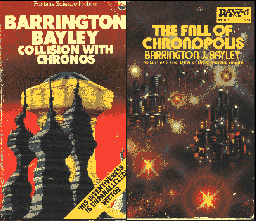 The first was COLLISION COURSE, (retitled for U.K.
publication, and hereafter referred to as COLLISION WITH CHRONOS) which appeared
in America published by DAW in 1973. Its obvious precendents would be
Brian Aldiss' AN AGE and
Philip K. Dick's COUNTER-CLOCK WORLD which both advocate the idea of temporal
reversion, the time-flow progressing backwards from future into past. With
typical Bayleyesque thoroughness he took this tour de force of a concept and
used it as step one. His conjecture saw time advancing in both directions
simultaneously - and the two streams colliding in a temporal apocalypse. Further
to that he suggested the idea of time as a highly localised wave phenomena,
ripples moving at different speeds, in different directions and cycles in
different areas of the galaxy. A temporary disturbance producing life as an
incidental side effect , trapped inescapably by its limitations. This
ideological core provided a lift-off point for Bayley's second foray into
temporal conundrum, THE FALL OF CHRONOPOLIS, an even
more fully realised
narrative. It also pictures time as being "composed of a wave structure".
But this time the scenario is an Earth where "the nodes of the wave travel at
intervals of approximately one hundred and seventy years". The Empire of
Chronopolis spans seven such nodes which form "the seven continents or
provinces of the Empire, while the intervening periods comprise a series of
hinterlands". The nodes are connected by regular commercial Timeliners and
by mercantile trade. Bayley delights in the potential complexity of the
situation, piling concept on concept into a staggering theoretical pyramid which
sees time, like recording tape, regularly overdubbed, looped, spliced, phased,
edited, or wiped clean. But for the protagonist there is no escape from its
illogic, for consciousness is constantly recycled through the same lifetime (as
in the short-story "Life Trap"). In the novel, prior to the Ixian Chronotic
Empire lies the 'stop barrier' predating the evolution of technology, while
futurewards lies the enemy Hegemonics who raid the Empire, disrupting its
history. Vast timeships of both forces patrol the Strat (the temporal substratum
of potential unrealised time) like warring spaceships in some garish Space
Opera. Bayley is not only formulating the principles of time-drives powering
such craft, but also outlining the distortion effects of 'speed' through time,
in the physical altering of proportions.
The first was COLLISION COURSE, (retitled for U.K.
publication, and hereafter referred to as COLLISION WITH CHRONOS) which appeared
in America published by DAW in 1973. Its obvious precendents would be
Brian Aldiss' AN AGE and
Philip K. Dick's COUNTER-CLOCK WORLD which both advocate the idea of temporal
reversion, the time-flow progressing backwards from future into past. With
typical Bayleyesque thoroughness he took this tour de force of a concept and
used it as step one. His conjecture saw time advancing in both directions
simultaneously - and the two streams colliding in a temporal apocalypse. Further
to that he suggested the idea of time as a highly localised wave phenomena,
ripples moving at different speeds, in different directions and cycles in
different areas of the galaxy. A temporary disturbance producing life as an
incidental side effect , trapped inescapably by its limitations. This
ideological core provided a lift-off point for Bayley's second foray into
temporal conundrum, THE FALL OF CHRONOPOLIS, an even
more fully realised
narrative. It also pictures time as being "composed of a wave structure".
But this time the scenario is an Earth where "the nodes of the wave travel at
intervals of approximately one hundred and seventy years". The Empire of
Chronopolis spans seven such nodes which form "the seven continents or
provinces of the Empire, while the intervening periods comprise a series of
hinterlands". The nodes are connected by regular commercial Timeliners and
by mercantile trade. Bayley delights in the potential complexity of the
situation, piling concept on concept into a staggering theoretical pyramid which
sees time, like recording tape, regularly overdubbed, looped, spliced, phased,
edited, or wiped clean. But for the protagonist there is no escape from its
illogic, for consciousness is constantly recycled through the same lifetime (as
in the short-story "Life Trap"). In the novel, prior to the Ixian Chronotic
Empire lies the 'stop barrier' predating the evolution of technology, while
futurewards lies the enemy Hegemonics who raid the Empire, disrupting its
history. Vast timeships of both forces patrol the Strat (the temporal substratum
of potential unrealised time) like warring spaceships in some garish Space
Opera. Bayley is not only formulating the principles of time-drives powering
such craft, but also outlining the distortion effects of 'speed' through time,
in the physical altering of proportions.
Produced in the same year (1974) SOUL OF THE ROBOT
switches the emphasis to
robotics, resurrecting Jasperodus, the robot hero of his 1956 story "Fugitive".
In the short story, set in the year 3368, the robot destroyed the city-state of
Birmingham in much the same way that he was to engineer the sack of Tansiann,
capital city of Earth's Second Empire. Over the twenty year gestation period
Jasperodus has acquired ambitions above his station and wants to sniff out the
roads to freedom. With the novel Bayley drags robotics a long way from the
Ptolomian-cosy universe of Asimov's neatly defined laws - through a Copernican
revolution and out the other side into bleak existentialism. His is a terrain in
which robots have nightmares, are troubled by their guilt-feeling of inadequacy,
suffer from Marxist alienation, and Freudian penis envy. We get 'robot as black'
(moving from plantation to Kansas or Detroit, to become hooked on booze or junk
- robots sell parts of their brain to buy 'shots'), robot as proletariat
(Jasperodus expounds "I believe the root cause of poverty lies in the private
ownership of the land"), robot as the exact incarnation of the 'ghost in the
machine', or Pascal's 'thinking reed'. Bayley is a writer of ideas, and it is
inevitably the ideas that remain, and the issue here is predominantly that of
Free Will. Bayley pointing out that this dilemma troubling Jasperodus throughout
the novel is not one unique to a robot, but one that must remain universal to
all forms of sentient life. Yet, although such questions always lie just beneath
the novel's surface, they are never allowed to interfere with the pace of the
action as Jasperodus contrives the downfall of monarchs, attempts to get high on
alien psychedelics, acquires a detatchable penis, engineers a robot
insurrection, is involved in court intrigues and the rise and fall of an empire,
is taken apart and reassembled, and searches for his roots. Perhaps Bayley's
most accomplished novel, it is similarly aware of a degree of absurdity and the
basic black humour of its situation. "The robot has mettle" puns King Zhorm at
one point!
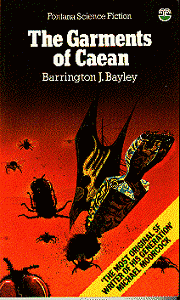 His second novel for Doubleday, THE GARMENTS OF CAEAN,
followed two years
later, and was fattened out by about 10,000 words for its 1977 U.K. publication.
The theme is again that of internal/external relationships, the question of Free
Will, and alieness. The Caeanics, a 'nation' made up of hundreds of planets in
the Tzist Arm, are human exoskeletals, their consciousness focussed not inwards
but on externals. They are, to use Bayley's term, 'clothes robots'. "Body image
is self image" states one of his characters, implying that the human mind is
malleable, reacting to its environment - and hence its most immediate
environment, its physical form. "The evolution of his physical form beyond the
status of the hairless ape could not be left to blind biological forces"
continues the argument. "It had to be done by conscious art. In a word, it was
to be accomplished by means of raiment". Stated in these terms the issue sounds
like a mildly interesting, if not vaguely self-indulgent and dilettante cultural
experiment. It is only when the full implication of Caeanic culture becomes
obvious, its startling origins, and the insiduous influence of the devious
Prossim, that the Caeanic philosophy assumes menace. Placed in a different body,
Bayley asks, does human consciousness remain the same, or does it adopt new
psychological outlooks to match the form? It is an extension of the idea
suggested by the short story "Maladjustment" in which a man is psychologically
altered to enjoy his exile on a hostile planet. The writing is economical and
concise, the vocabulary wide; the style perfectly balanced between the extremes
of the imaginatively credible and the outrageous; and the plot is, on the whole,
well-constructed, plot and sub-plot merging together in pleasing symmetry. He
can take Cyborgs and Metalloids (a culture from which Caeanic philosophy
evolved) cruising naked on open space-rafts - a concept as bizarre and mind-
boggling as the most outrageous fantasy - yet raise it all to a level of
literacy that such ideas have seldom before enjoyed or deserved. Or again, a
passage that recalls the full crass overstatement of a 1940's Horror pulp -"she
stopped and stood stock still, a petrified snarl of fear on her face, staring at
the apparition: Caster's suit now worn by a body of flies. The head, hands and
feet were each composed of a black fuzzy mass. The legs, even though they
floated a foot above the floor, persisted in striding slowly in walking fashion
as the monster came slowly towards her...". Built into the internal logic of the
passages concept, and also into the deliberately artless form from which it
derives its archetype, is a strong overtone of the surreal, in the most specific
application of the term. A later passage is as idiosyncratically surreal, with
all the intrinsic humour that the particular discipline implies. Like the
imaginary landscape of a surrealist painting Bayley wrote: "suits. Hundreds,
thousands of suits, accompanied by matching undergarments and accessories, were
growing all over the plain." Bayley's approach to THE GARMENTS
OF CAEAN is
almost a dialectical one. The reconciliation of internal stylistic
contradictions. He takes his thesis from various and diverse elements of science
fiction (and other) traditions; he provides the antithesis of intellectual and
literary integrity fused with his own restless freshness of vision; and emerges
with a synthesis in the form of the third in a trilogy of brilliant novels.
His second novel for Doubleday, THE GARMENTS OF CAEAN,
followed two years
later, and was fattened out by about 10,000 words for its 1977 U.K. publication.
The theme is again that of internal/external relationships, the question of Free
Will, and alieness. The Caeanics, a 'nation' made up of hundreds of planets in
the Tzist Arm, are human exoskeletals, their consciousness focussed not inwards
but on externals. They are, to use Bayley's term, 'clothes robots'. "Body image
is self image" states one of his characters, implying that the human mind is
malleable, reacting to its environment - and hence its most immediate
environment, its physical form. "The evolution of his physical form beyond the
status of the hairless ape could not be left to blind biological forces"
continues the argument. "It had to be done by conscious art. In a word, it was
to be accomplished by means of raiment". Stated in these terms the issue sounds
like a mildly interesting, if not vaguely self-indulgent and dilettante cultural
experiment. It is only when the full implication of Caeanic culture becomes
obvious, its startling origins, and the insiduous influence of the devious
Prossim, that the Caeanic philosophy assumes menace. Placed in a different body,
Bayley asks, does human consciousness remain the same, or does it adopt new
psychological outlooks to match the form? It is an extension of the idea
suggested by the short story "Maladjustment" in which a man is psychologically
altered to enjoy his exile on a hostile planet. The writing is economical and
concise, the vocabulary wide; the style perfectly balanced between the extremes
of the imaginatively credible and the outrageous; and the plot is, on the whole,
well-constructed, plot and sub-plot merging together in pleasing symmetry. He
can take Cyborgs and Metalloids (a culture from which Caeanic philosophy
evolved) cruising naked on open space-rafts - a concept as bizarre and mind-
boggling as the most outrageous fantasy - yet raise it all to a level of
literacy that such ideas have seldom before enjoyed or deserved. Or again, a
passage that recalls the full crass overstatement of a 1940's Horror pulp -"she
stopped and stood stock still, a petrified snarl of fear on her face, staring at
the apparition: Caster's suit now worn by a body of flies. The head, hands and
feet were each composed of a black fuzzy mass. The legs, even though they
floated a foot above the floor, persisted in striding slowly in walking fashion
as the monster came slowly towards her...". Built into the internal logic of the
passages concept, and also into the deliberately artless form from which it
derives its archetype, is a strong overtone of the surreal, in the most specific
application of the term. A later passage is as idiosyncratically surreal, with
all the intrinsic humour that the particular discipline implies. Like the
imaginary landscape of a surrealist painting Bayley wrote: "suits. Hundreds,
thousands of suits, accompanied by matching undergarments and accessories, were
growing all over the plain." Bayley's approach to THE GARMENTS
OF CAEAN is
almost a dialectical one. The reconciliation of internal stylistic
contradictions. He takes his thesis from various and diverse elements of science
fiction (and other) traditions; he provides the antithesis of intellectual and
literary integrity fused with his own restless freshness of vision; and emerges
with a synthesis in the form of the third in a trilogy of brilliant novels.
Two further novels complete the canon. THE GRAND WHEEL
takes the science of
randomness as its theme, offering a mathematical formula defining luck, which
(as in the P.F. Woods story "Reactionary") is limited by the laws of
conservation! All that is known, understandable and predictable sailing like a
wafer-thin ship on the vastness of non-causation and irrationality, "the gulf
pure randomness that underlies all existence". Cheyne Scarne is a gambler down
on his luck, washed up on Io, moon of Jupiter. He finds himself addicted to a
personalised narcotic, and caught up in three major areas of conflict; a split
dividing the human-colonised worlds between the inflexible 'Legitimacy' and the
mafioso 'Grand Wheel'; the Legitimacy's war against the conquering alien
Hadranics; and the Grand Wheel's attempt to enter a Galactic gaming syndicate by
gambling off half the human race. Bayley's ideas are conveyed rapidly through a
compulsive plot-mix of action.
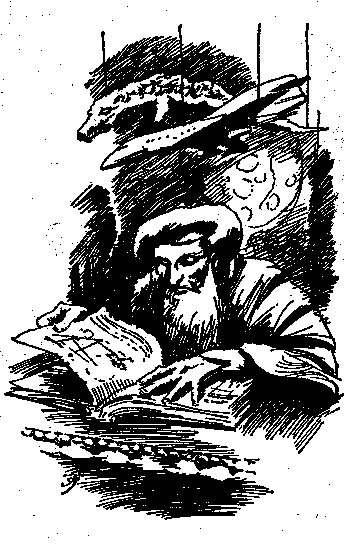 The latest DAW novel, STAR WINDS, started out
under the title 'Galactic
Alchemist', returning to motifs lighted on briefly in EMPIRE
OF TWO WORLDS. The
earlier novel introduces Alks (Alchemists), a discipline developed in the later
novel into a complex consistant alternative technology which can even explain
nuclear fission. The amount of researched detail, and the utilisation of the
information to bolster the tale is impressive. In 1972 Bayley had written of an
'egg' made of Tincture, the prima materia of existence which provides an extra-
dimensional bridge between Killibol and the Earth. In STAR WINDS
the material is
again used, this time as the objective in an alchemical quest. The novel is
delineated into two sections, the first and by far the most satisfying section
dealing with an evocative voyage from Earth to Mars in a 'sailing' ship that
sails the ocean of space riding the solar winds. While writing the chapter
dealing with the Martian landing Bayley recalls that the "American Mars
lander was sending back excellent colour tv pictures, weather reports and soil
analyses of the Martian surface. My first thought was "this really is it.
Science Fiction isn't special anymore". And incredibly, that overshadowed the
interest I felt in what actually was a very exciting event." As if in
response to this depression the second section of the novel loses some of its
hermetic concision. The initial quest for a supply of sail-cloth, is forgotten.
The Martian location is anti-climatically ignored in favour of a less unique
Galactic vista, and although the novel remains competent, with some exciting and
inventive passages, it never quite delivers the promise of the first
chapters.
The latest DAW novel, STAR WINDS, started out
under the title 'Galactic
Alchemist', returning to motifs lighted on briefly in EMPIRE
OF TWO WORLDS. The
earlier novel introduces Alks (Alchemists), a discipline developed in the later
novel into a complex consistant alternative technology which can even explain
nuclear fission. The amount of researched detail, and the utilisation of the
information to bolster the tale is impressive. In 1972 Bayley had written of an
'egg' made of Tincture, the prima materia of existence which provides an extra-
dimensional bridge between Killibol and the Earth. In STAR WINDS
the material is
again used, this time as the objective in an alchemical quest. The novel is
delineated into two sections, the first and by far the most satisfying section
dealing with an evocative voyage from Earth to Mars in a 'sailing' ship that
sails the ocean of space riding the solar winds. While writing the chapter
dealing with the Martian landing Bayley recalls that the "American Mars
lander was sending back excellent colour tv pictures, weather reports and soil
analyses of the Martian surface. My first thought was "this really is it.
Science Fiction isn't special anymore". And incredibly, that overshadowed the
interest I felt in what actually was a very exciting event." As if in
response to this depression the second section of the novel loses some of its
hermetic concision. The initial quest for a supply of sail-cloth, is forgotten.
The Martian location is anti-climatically ignored in favour of a less unique
Galactic vista, and although the novel remains competent, with some exciting and
inventive passages, it never quite delivers the promise of the first
chapters.
Unlike certain U.K.-based writers attempting to breach more lucrative markets,
Bayley does not adopt an American orientation in terminology, in standards of
literacy, or in concepts. He stands very much in the Wells-Stapledon-Aldiss
lineage. Such writers were aware that one of the precepts of art is to change or
alter perceptions, and, as one of the most directly accesible forms of
contemporary art, that particular branch of experimental writing known as
Science Fiction is at its most valid when attempting this process of
consciousness-alteration. THE GARMENTS OF CAEAN and
"The Cabinet of Oliver
Naylor", in the tradition of THE TIME MACHINE and LAST AND FIRST MEN, manage to
achieve this. It seems to me that in this way Bayley is both eclectic and
dynamically original. He is the conscious inheritor not only of the tools of the
Science Fiction tradition, but the spirit of awe and revelation with which the
tradition was born. His style draws on SF convention more directly than any
other New Wave experimental writer, yet uses those exact conventions in such a
way that they come up refurbished and new. He can restore faith in devalued
’sense of wonder’ using implements that, in the hands of less competent writers,
remain as dry as the seas of Mars. Barrington J. Bayley treats writing as a
conceptual game. To the reader who merely wants good knockabout entertainment it
may appear that he occasionally gets bored with the tedious necessity of plot
continuity, and therefore hurries passages - to more speedily reach the next
unfolding section of ideas. But the decade of the 1970’s, and more specifically
those years straddling the middle of the decade that saw the publication of ’The
Radius Riders’, THE FALL OF CHRONOPOLIS, ’The Bees of
Knowledge’, ’Exit from City 5’, and SOUL OF THE ROBOT,
has produced a unique wealth of material seldom equalled in science fiction.
(c) Andy Darlington, 1980-1998.
Originally published in Arena #10 (1980)
[bibliography]
[home]
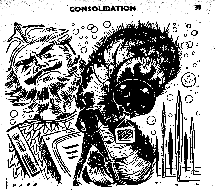 Bayley's forming penchant for abstraction took the
temperature of the world to its theoretical laboratory extreme, where 'every
atom and molecule of the whole planet is frozen immobile. No chemical change. No
energy exchange. Nothing. It's a world without time.' Less a literary device,
more a physics abstraction. But the story is well developed, the brother of the
title 'printed' into a massive electrical charge eternally fused into the
planet. Another by-line, John Diamond, resulted in the sale of a story called
"Consolidation" to Nebula, the unique Glasgow magazine edited by Peter
Hamilton. The story featured a stagnant Terran society confident in the
protection of a ring of virile colonies. It was shocked from its contented
lethargy and revitalized by an attack from space, the raiders turning out to be
those same ex-colonists. To Bayley the tale represents an attempt to produce
more commercially acceptable material. Efforts he now disowns as disasterous.
Bayley's forming penchant for abstraction took the
temperature of the world to its theoretical laboratory extreme, where 'every
atom and molecule of the whole planet is frozen immobile. No chemical change. No
energy exchange. Nothing. It's a world without time.' Less a literary device,
more a physics abstraction. But the story is well developed, the brother of the
title 'printed' into a massive electrical charge eternally fused into the
planet. Another by-line, John Diamond, resulted in the sale of a story called
"Consolidation" to Nebula, the unique Glasgow magazine edited by Peter
Hamilton. The story featured a stagnant Terran society confident in the
protection of a ring of virile colonies. It was shocked from its contented
lethargy and revitalized by an attack from space, the raiders turning out to be
those same ex-colonists. To Bayley the tale represents an attempt to produce
more commercially acceptable material. Efforts he now disowns as disasterous.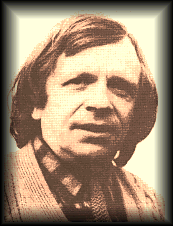 Barrington J. Bayley
Barrington J. Bayley
 While living
in Dublin Bayley read THE NAKED LUNCH, one of the most uncompromisingly experimental
novels of the century. The effect was a slap in the mind, by example as well as by
technique. The first piece he regurgitated under its pervasive influence was "The
Four Colour Problem", a densely worded mindbuster, part thesis, part cut-up comment,
interacting and cohabiting the page in perfect artistic cohesion. The Burroughs
influence is overwhelming, with repetitive motifs of 'pulse trains', 'social ovens',
'a blazing bomber plunging down bottomless pits', Vietnam, the Ohio State and Kennedy
killings, DNA, and the Four Colour problem itself linked by sharp jagged vignettes of
fragmented military and vorticed political satire in a continually unfolding juxtaposition
of imagery. There is explication on forms of addiction, geometric diagrams, and even a
Doctor Benway figure in Bayley's Professor Gottram, compounded by Burroughs ubiquitous
sex-energy references. Written in a manic high pitch of tension, and illustrated by for
New Worlds by the late Mal Dean, it remains his
most personally satisfying text ever.
While living
in Dublin Bayley read THE NAKED LUNCH, one of the most uncompromisingly experimental
novels of the century. The effect was a slap in the mind, by example as well as by
technique. The first piece he regurgitated under its pervasive influence was "The
Four Colour Problem", a densely worded mindbuster, part thesis, part cut-up comment,
interacting and cohabiting the page in perfect artistic cohesion. The Burroughs
influence is overwhelming, with repetitive motifs of 'pulse trains', 'social ovens',
'a blazing bomber plunging down bottomless pits', Vietnam, the Ohio State and Kennedy
killings, DNA, and the Four Colour problem itself linked by sharp jagged vignettes of
fragmented military and vorticed political satire in a continually unfolding juxtaposition
of imagery. There is explication on forms of addiction, geometric diagrams, and even a
Doctor Benway figure in Bayley's Professor Gottram, compounded by Burroughs ubiquitous
sex-energy references. Written in a manic high pitch of tension, and illustrated by for
New Worlds by the late Mal Dean, it remains his
most personally satisfying text ever. The title quite literally describing a ship existing in some other, more tenuous,
dimension, only its keel extending down into the abyss of what we understand as
the universe. To its crew we are the Subearthers. Into the realm of even greater
tenuity "Exit from City 5" proffered the idea of a self-perpetuating society
escaping the extinction of the entire sidereal universe by going beyond into
the total void of theoretical nothingness. By a simple inversion of this spatial
condition Bayley produced a universe of solid rock flecked with inhabited
air-pocket 'planets' in "Me and my Antronoscope". The problem afflicting this
society being that of procuring 'fresh emptiness'.
The title quite literally describing a ship existing in some other, more tenuous,
dimension, only its keel extending down into the abyss of what we understand as
the universe. To its crew we are the Subearthers. Into the realm of even greater
tenuity "Exit from City 5" proffered the idea of a self-perpetuating society
escaping the extinction of the entire sidereal universe by going beyond into
the total void of theoretical nothingness. By a simple inversion of this spatial
condition Bayley produced a universe of solid rock flecked with inhabited
air-pocket 'planets' in "Me and my Antronoscope". The problem afflicting this
society being that of procuring 'fresh emptiness'.
 Bayley
met William Burroughs at a party, and the venerable beat complemented certain
passages. John Brunner was also highly vocal in urging Bayley to expand the
piece to novel-length. A contract with Don Wollheim of DAW books reduced
options into commitments, and Bayley settled down and became a novelist. The re-
alignment inevitably required a period of adjustment. The stated intention was
to write standard space opera, and after adapting two New Worlds
novelettes into Ace doubles, STAR VIRUS and
ANNIHILATION FACTOR, he produced
EMPIRE OF TWO WORLDS which again raided the past. The first half of the
novel was expanded from an unpublished story from the 'draught' period, although
he pruned it of a peculiar abbreviated style of dialect he'd invented just for
the story. It used a 'gangster' motif with dialogue redollent of such 40's movie
jargon as "case the joint". It is more affectionate tribute than expedient
attempts at literary gate-crashing of the movie market.
EMPIRE OF TWO WORLDS
pictured the human race divided between three worlds, the gentle artistic Rheatt
of Earth; the barbaric E. R. Burroughs-Martian Rotrox of the moon (which orbits
a mere 80,000 miles from its primary); and the mobster-ruled Mound cities of
Killibol, a dark world in another galaxy. It was the last of the transitional
novels and was followed by a fistfull of the decades most impressive works.
Bayley
met William Burroughs at a party, and the venerable beat complemented certain
passages. John Brunner was also highly vocal in urging Bayley to expand the
piece to novel-length. A contract with Don Wollheim of DAW books reduced
options into commitments, and Bayley settled down and became a novelist. The re-
alignment inevitably required a period of adjustment. The stated intention was
to write standard space opera, and after adapting two New Worlds
novelettes into Ace doubles, STAR VIRUS and
ANNIHILATION FACTOR, he produced
EMPIRE OF TWO WORLDS which again raided the past. The first half of the
novel was expanded from an unpublished story from the 'draught' period, although
he pruned it of a peculiar abbreviated style of dialect he'd invented just for
the story. It used a 'gangster' motif with dialogue redollent of such 40's movie
jargon as "case the joint". It is more affectionate tribute than expedient
attempts at literary gate-crashing of the movie market.
EMPIRE OF TWO WORLDS
pictured the human race divided between three worlds, the gentle artistic Rheatt
of Earth; the barbaric E. R. Burroughs-Martian Rotrox of the moon (which orbits
a mere 80,000 miles from its primary); and the mobster-ruled Mound cities of
Killibol, a dark world in another galaxy. It was the last of the transitional
novels and was followed by a fistfull of the decades most impressive works. The first was
The first was  His second novel for Doubleday,
His second novel for Doubleday,  The latest DAW novel,
The latest DAW novel,